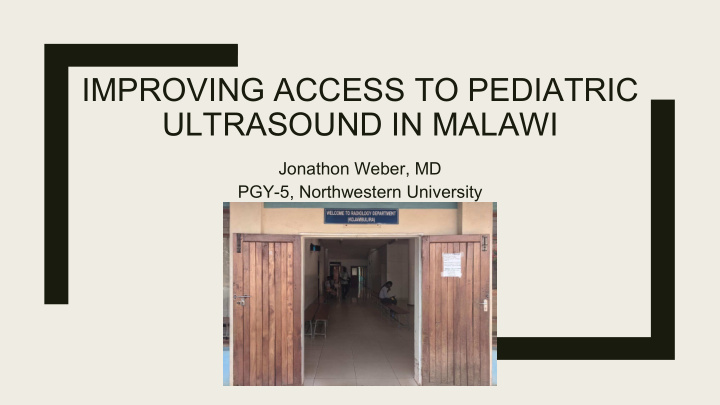



IMPROVING ACCESS TO PEDIATRIC ULTRASOUND IN MALAWI Jonathon Weber, MD PGY-5, Northwestern University
Brief Introduction to Malawi • Malawi is a landlocked country in southeast Africa • Malawi has one of the lowest GDP/capita rates in the world, although this is improving • Malawi has one of the highest rates of HIV/AIDS in the world • Endemic for other infectious diseases such as malaria, TB, schistosomiasis, yellow fever, typhoid, hepatitis A, rabies • Malawi ranks 185/190 in the WHO report of health systems development. Mix of private and public hospitals
Kamuzu Central Hospital • KCH is a tertiary public hospital in the country’s largest city, Lilongwe • Approximately 600-1,000 beds, although the hospital is almost always above capacity • Estimated 70% of admissions are related to infectious disease/HIV-related illness • Equipment currently includes one stationary US machine with ECHO capabilities (Mindray) and two portable Sonosite machines, one of which includes ECHO capabilities
Radiology Needs Assessment • A pediatric death audit study at KCH reviewing data from 2014-15 demonstrated that 14.6% of patients whose deaths were reviewed had delays of greater than 24 hours in obtaining radiology studies • Surveys and brief interviews were performed to gauge pediatric providers perceptions regarding the use of bedside ultrasound in pediatric acute care at KCH. Challenges identified by local clinicians: Rotating consultants (some use POCUS, some do not) • Limited access to formal diagnostic imaging (CT, US) and/or specialty imaging (echo) • Accessibility of portable ultrasound machine • No formal training in using an ultrasound machine • • Limited time for education or training when added to normal work requirements • Compensation for learning No opportunity for reciprocal exchange or visiting a setting where this skill is used •
RAD-AID Malawi Initiatives • Partnership between RAD-AID, UNC RAD-AID Chapter, and KCH started in 2013 after a radiology readiness assessment was completed • Goals of RAD-AID include improving technical skill and curriculum of local sonographers, improving patient (specifically pediatric) access to ultrasound exams Identified a cohort of learners of which to provide longitudinal mentorship to adapt and • manage the needs of the local healthcare environment Ensure sustainability of intervention by qualifying learners to have ability to train future • technologists • Partnership between RAD-AID and Malawi Children’s Initiative began in 2019. The first volunteers traveled in August-December 2019 • Focus of utilizing imaging in critically ill patients in pediatric wards, training clinical officers and radiographers in pediatric POCUS
2019 Didactic Curriculum Schedule
Goal: Improve Access for Pediatric Patients to Ultrasound • Two dedicated US rooms in the KCH Radiology department Majority of pediatric patients are evaluated with the higher-quality Mindray machine • Afternoons designated for portable exams for pediatric patients too ill to make it to the • radiology department • Build relationships with local clinicians Close relationship with pediatric oncology for urgent consultation and help with image- • guided biopsies Dr. Bip Nandi is the pediatric surgeon at KCH and frequently texted our group via • WhatsApp for urgent exams and follow up. He also provided us direct feedback with surgical findings on patients we examined with him Fanuel Betchani trained in pediatrics, but has an interest in POCUS •
Recommend
More recommend